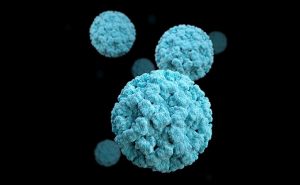Two Cases Of Norovirus Have Been Found In Thiruvananthapuram:

At least two cases of norovirus have been found in Thiruvananthapuram among lower primary school students.
- Norovirus is a highly contagious virus that is also sometimes referred to as the ‘stomach flu’ or the ‘ winter vomiting bug’.
It can be transmitted through contaminated food, water, and surfaces. - The primary route is oral-faecal.
- It is similar to diarrhoea-inducing rotavirus and infects people across age groups.
- One may get infected multiple times as the virus has different strains.
- Disease outbreaks typically occur aboard cruise ships, in nursing homes, dormitories, and other closed spaces.
- According to WHO, an estimated 685 million cases of norovirus are seen annually, including 200 million cases amongst children under 5
- The initial symptoms of norovirus are vomiting and/or diarrhoea, which show up one or two days after exposure to the virus.Patients also feel nauseous, and suffer from abdominal pain, fever, headaches and body aches.
- In extreme cases, loss of fluids could lead to dehydration.
- Norovirus infection is associated with intestinal inflammation, malnutrition and may cause long-term morbidity.
- Diagnosis is done by real-time reverse transcription-polymerase chain reaction.
- No vaccines are available for the disease.
- The basic precaution is repeatedly washing hands with soap after using the lavatory or changing diapers.
- It is important to wash hands carefully before eating or preparing food.
- During outbreaks, surfaces must be disinfected with a solution of hypochlorite at 5,000 parts per million.
- Those infected should avoid contact with others and avoid preparing food for others while sick and for two days after symptoms stop.
- Norovirus is resistant to many disinfectants and can withstand heat up to 60°C.
- Therefore, merely steaming food or chlorinating water does not kill the virus.
- The virus can also survive many common hand sanitisers.
- The disease is self-limiting.
- The infection normally lasts only two or three days, and most individuals who are not very young, very old, or malnourished can ride it out with sufficient rest and hydration.
- It is important to maintain hydration in the acute phase.
- In extreme cases, patients have to be administered rehydration fluids intravenously.




